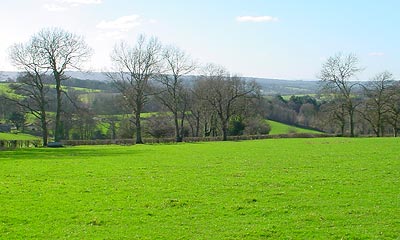The birds that blocked 20,000 new homes
Huge building development across 300 square miles of south-east England is frozen to protect three rare species: the Dartford warbler (Sylvia undata), the nightjar (Caprimulgus europaeus) and the woodlark (Lullula arborea)
All plans for new housebuilding have been frozen over a massive area of the Home Counties to protect three species of rare birds in the most remarkable clash yet between environment and development in Britain.
Concerns about the welfare of the nightjar, the woodlark and the Dartford warbler have halted schemes for building thousands of homes over an expanse of nearly 300 square miles, stretching from the M25, west of London, almost to Reading. The unprecedented moratorium has come about because the hitherto-irresistible force of the housing boom in the South-east has run into the immovable object of European Union wildlife protection law, which safeguards the three bird species in a formidable way.
Acting under advice from the government's wildlife agency, English Nature, 11 local authorities in Surrey, Hampshire and Berkshire have frozen all new housing planning applications since October last year inside a vast cordon around the birds' breeding habitats, patches of heather-covered lowland heath dotted across the area. In doing so they have put future plans for up to 20,000 houses on indefinite hold and caused anguish among local building firms, some of which say they have had to sack staff. The Home Builders' Federation wants the Government to step in as a matter of urgency.

Yet the situation can be resolved, says English Nature, if the local councils adopt a radical plan and provide new public open space to accompany all new development, which would absorb the extra pressure from visitors that might otherwise put the birds' nesting success at risk.
The councils are at present considering the plan, while an audit is carried out of all the land in the area that might be available to provide new open space.
In the meantime, the Government is seriously alarmed at the head-on collision between the very different imperatives of housing provision and nature protection. The Department for Environment, Food and Rural Affairs (Defra) strongly supports English Nature's position; but John Prescott's Office of the Deputy Prime Minister (ODPM), which looks after housing, is commissioning new research which might see the agency's position undermined.
In the little publicity previously afforded to the issue, the ban has been presented as ridiculous: all those houses held up for a few little birds. But in truth it is serious and has been waiting to happen, as the colossal development of England's overcrowded South-east - into which the Government wants to put another 580,000 houses over the next 20 years - rolls on unchecked. Sooner or later the seemingly unstoppable juggernaut was bound to hit a barrier of some sort. Now it has.
At issue is not just the fate of the birds, but the protection of the lowland heath on which nightjars, woodlarks and Dartford warblers make their nests, one of England's most attractive and wildlife-rich but fastest-disappearing habitats.
Recent research has convinced English Nature that public access to heaths - especially people walking dogs - is a much greater threat to the breeding success of all three species that had previously been realised. With the group of heathlands nearest to London, the agency is now formally objecting to any further residential development within five kilometres.
In doing so, it insists it is simply carrying out its obligations to implement EU law.
There are 13 major stretches of lowland heath due west of London, such as Chobham Common in Surrey. Individually, they are already Sites of Special Scientific Interest (SSSIs) under British legislation, because of the richness of their wildlife. But they have been further designated, collectively, as the Thames Basin Heaths Special Protection Area (SPA) under the EU's 1979 birds directive, expressly to safeguard the nightjars, woodlarks and Dartford warblers that nest on them.
The directive, transposed into English law as the Habitats Regulations 1994, is extremely tough, and forbids anything likely to have a "significant effect" on the species for which an area was selected. In the past, English Nature concentrated its protection efforts on the management of the heaths themselves, but several studies over the past four years have convinced staff that success in bird breeding is correlated with visitor pressure - the more visitors, the fewer successful nests. Both nightjar and woodlark nest on the ground, while the Dartford warbler nests low down in gorse bushes, and all three are likely to be flushed from the nest by visitors' dogs, leaving eggs and chicks at the mercy of predators. Although the agency has long insisted on a 400-metre building exclusion zone around protected heathlands, it now believes that people who use the heaths come from farther away than was generally appreciated and a much wider residential building exclusion zone is now necessary.
Since October last year the agency has formally objected to any housing application within five kilometres of the SPA. These 5km zones link together to form an oval area 30 miles across at its widest point and 15 miles deep, taking in such towns as Guildford, Woking, Camberley, Bracknell and Ascot - the very heartland of booming south-east England, "Britain's California" - where demand for new housing development is immense.
The 11 local councils concerned, following legal advice, are now refusing every housing application for the area. It is impossible to give a precise figure for new houses put on hold, but local builders estimate that plans for more than 3,000 new homes have already been stalled. But if the issue is not resolved, that total is certain to rise steeply. The new housing allocation for the 11 councils is 40,000, of which about 35,000 fall inside the affected area - that is, within five kilometres of one of the heaths. Some of these have been built so a figure of 20,000 new homes likely to be held up is probably nearer the true picture.
The scheme that English Nature is putting forward to solve the problem, labelled the Thames Basin Heaths Delivery Plan, is an entirely new approach to spatial planning, because it would mean that individual housing applications would not necessarily have to be assessed individually for their impact on the SPA.
Instead, land "in mitigation" - alternative open space to soak up added public pressure expected from the new homes - could be provided strategically for the whole area.
The main objection from housebuilders to English Nature's position is that the 5km exclusion zone around the SPA is too wide.
However, the agency's chief executive, Dr Andy Brown, said: "All the evidence we can put together suggests that anything within that sort of radius, in terms of new development, is going to have some effect on the bird populations of the sites.
"But we know how to offset that effect - by creating additional green space. So it is possible to have housing in the area if developers and local authorities can work together with the delivery plan."
Untamed England
Heathland, the home of the three bird species which have halted a building boom, is the last truly wild part of the countryside of southern England.
The nightjars, woodlarks and Dartford warblers of the Thames Basin Heaths are characteristic creatures of a special place. While the intimate pattern of small woods and fields that make up most of the South is charming, it is undeniably domesticated.
Lowland heath is quite different. These tracts of dark heather, interspersed with gorse and silver birch, feel untamed, like an entirely different landscape, a different country almost. Bagshot Heath, on the borders of Surrey and Berkshire, feels like it could be in Russia. They are wonderful places to walk.
And, because they are untouched by agriculture, the heaths of the South are rich in wildlife. Chobham Common, near the junction of the M25 and M3 motorways, has recorded 350 species of wild flower, 100 species of bird and 23 species of mammal.
But these heathlands are mere mini-remnants of the huge stretches that once covered much of southern England. Now more than three-quarters of them are gone, and only three major chunks remain: the Dorset Heaths, the Wealden Greensand Heaths in Sussex, and the Thames Basin Heaths west of London.
independent.co.uk, 02.05.06
